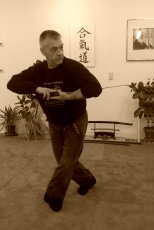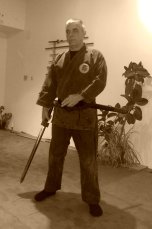In the Bujinkan there is the concept of 劒体一条 ken tai ichijô (body and weapon are one).
This concept makes a lot of sense when wielding a heavy sword in 片手 katate (one hand) because the free arm is often in the way. And this is even more difficult to manage as the blade is double edged.
We discovered this same problem when we studied the Tachi. But with the Ken this is even more accurate.
In the Kukishin ryû one of the kotsu is to “keep the elbows/arms close to the body”, this is for the same reason. If you train with the 万力鎖 manriki gusari this is also mandatory.
When I was stationed in Lebanon for the UN, I attended a very interesting Kukri* demonstration by the Nepalese Army. It was impressive and I noticed that the 200 soldiers moving in unisson always kept their free arm off the weapon for themselves and also for their neighbours. I took a video that I might post here one day.
So, as we are discovering the Ken, please keep your free arm as close as possible to the body at all time. Whatever you do with a new weapon has to begin slow. The first achievement is to avoid getting injured by it.
- A weapon has no conscience and no intention. It moves naturally following the laws of 重力 jû ryoku (gravity).
- A weapon is not impressed by your rank, it will do what your body movements make it do.
- Therefore a weapon has to become truly a “natural extension” of your body/mind in order to avoid accidents.**
Confidence and ease are the natural results of heavy and long rehearsal. So please train slowly your katate movements, they are very powerful and devastating with such a heavy sword. Your security (and the one of your neighbours) should always be your first concern in training. Don’t be too presomptuous about your own abilities, learn step by step, and keep your free arm to your body.
If you don’t pay attention and don’t learn these movements correctly in slow motion then, instead of 劒体一条 ken tai ichijô, we will do 献体一冗 kentai ichijô, and “give your useless body to a hospital for medical research”. Interested?
*The khukuri (Nepali: खुकुरी) (alternatively spelled khukri or kukri) is a Nepalese knife with an inwardly curved edge, used as both a tool and as a weapon.For more information check THIS Wikipedia page.
**This is also valid for any object or weapon.
NB: In a previous post I wrote about the weakness of the wooden Taichi sword that can break easily when stopping an attack in the dôjô. Those of you using one, add a layer or two of duct tape and it will increase the security and lower the risks of injury during training. Also it will add a little more weight which is even better.


















